Thomas Harrison (1759 - 1844)
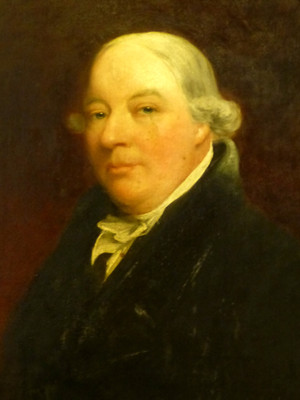
From a portrait by John Jackson, RA
held by Scarborough Museums and Galleries, with permission.
Born in Warrington, Thomas had been practicing medicine in the Kirkbymoorside area for over 40 years. He was well known in the county and had been a coroner for the North Riding of Yorkshire for about twenty years. His wife had died in 1815 and his only son in August 1821, leaving him with five daughters. Only the eldest, Mary, was married - to Robert Petch, owner of land adjoining the Kirkdale quarry and overlying some of the cave.
Annotated family tree
John Gibson (1778 - 1840)
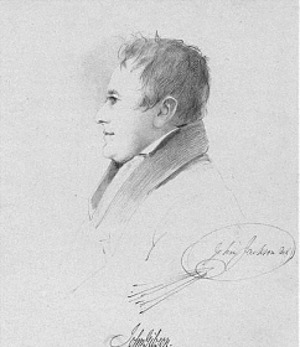
John Gibson by John Jackson RA
With thanks to St John's, Stratford for permission to use this image.
Both John and his wife Nanny (née Harrison) had been born in Kirkbymoorside but had for many years been living in Stratford, Essex. He was a manufacturing chemist (pharmacist) in partnership with the noted amateur meteorologist Luke Howard FRS (1772 - 1864). He may have been a descendent of the Gibson family which owned the Welburn estate (and quarry) until the middle of the 18th century. John is known to have organised the collection and shipping of bones to the Royal College of Surgeons. He was present at Bucklands address to the Royal Society in 1822 and reported on it to William Harrison.
Annotated family tree
Rev George Young (1777 - 1848)
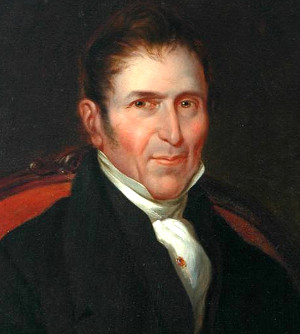
From a portrait held by Whitby Museum, with permission.
George Young born in Kirknewton, near Edinburgh and studied in Edinburgh and Stirling. He was appointed as Minister of the Cliff Lane Presbyterian Chapel Whitby in 1806. Unmarried at the time, he was was a noted author, scholar and linguist with a keen interest in local geology. Through life he remained a staunch supporter of the literal truth of the Old Testament story of creation.
Annotated family tree
Rev William Buckland (1784 - 1856)
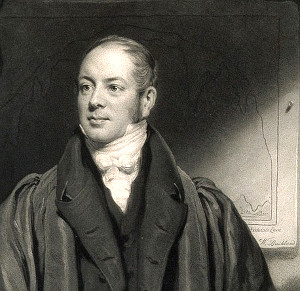
From a mezzotint by S. Cousins, 1833, after T. Phillips. Note that he is pictured in front of a plan of the Kirkdale cave.
Credit: Wellcome Collection. (CC BY 4.0) detail
William Buckland had been appointed reader in geology and mineralogy at Corpus Christi College, Oxford in 1813. His work on the Kirkdale cave fauna and interpretation of the site as an ancient Hyena den was one of his greatest academic achievements. For this he was awarded the Royal Society's Copley Medal in 1822. Mary Morland (1797 - 1857) prepared some of the illustrations in his 1823 "Reliquiae diluvianae" - they were married in 1825.
Annotated family tree
William Clift (1775 - 1849)
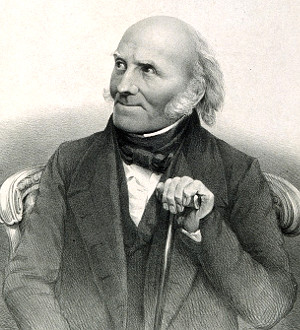
Lithograph by W. Bosley, 1849, after A. Claudet.
Credit: Wellcome Collection. (CC BY 4.0) detail
William Clift was the "Conservator", with charge of the collections of the Royal College of Surgeons. He was noted for the high quality of his anatomical illustrations. William later (1835) became the father-in-law of the zoologist Richard Owen (1804 - 1892).
William Salmond (1769 - 1838)
A York gentleman who had been born in Cumberland. His father, who died when William was 10, had been a plantation owner in Antigua; the family had lived in York since the turn of the century. His two surviving brothers had strong military connections but William appears to have had a brief career as an inspector of taxes and was a Captain in the Cumberland Militia. His two unmarried sisters were noted York philanthropists. He did not marry.
Annotated family tree
Rev William Eastmead (c1782 - 1830)
Little appears to be known of The Rev Eastmead other than that he was the minister of the Independent Chapel in Tinley Garth, Kirkbymoorside, a position he had held since about 1810. He had moved to Kirkbymoorside from Hambleden, Bucks. and is thought to have studied at the Hackney College. His somewhat eclectic 1824 Historia Rievallensis concludes with a review of the regional geology which demonstrates that he was reasonably well versed in the subject.
Kirkbymoorside
Note that this near-by small town was usually rendered as "Kirby Moorside" or even "Kirby Moor Side" (concatenation or hyphenation of the elements being optional). The extra "k", although sometimes encountered in early documents, is now considered to be the preferred form.
Publications
- Buckland, W. 1822. Account of an assemblage of Fossil Teeth and Bones of Elephant, Rhinoceros, Hippopotamus, Bear, Tiger, and Hycena, and sixteen other animals; discovered in a cave at Kirkdale, Yorkshire, in the year 1821 : with a comparative view of five similar caverns in various parts of England, and others on the Continent. Philosophical transactions of the Royal Society. 112 171-236
-
- Young, G. and Bird, J. 1822. A geological survey of the Yorkshire coast. Whitby.
-
- Young, G. 1822. On the fossil remains of quadrupeds, etc., discovered in the cavern at Kirkdale, in Yorkshire, and in other cavities or seams in limestone rocks. Memoirs of the Wernerian Natural History Society. 4, 262–70.
-
- Young, G. 1828. On the fossil remains of quadrupeds, etc., discovered in the cavern at Kirkdale, in Yorkshire, and in other cavities or seams in limestone rocks part II. Wernerian Natural History Society. 6, 171–183. (Read 30th November 1822)
-
- Buckland, W. 1823. Reliquiae diluvianae. London.
-
- Eastmead, W. 1824. Historia Rievallensis. London.
-
- John Gibson (1778-1840) Palaeontologist
Introduction
There are various versions in circulation concerning the discovery in 1821 of the Kirkdale bone cave near the small town of Kirkbymoorside, North Riding of Yorkshire. Although there is a general, although not universal, agreement over the major features of the story, the details and emphasis often depend on the teller. This document is an attempt to produce a consistent version of the story and to establish the relationships between the people involved in the collection and analysis of the Kirkdale fauna. Hyper-links have been used to link to other parts of the page without breaking the narrative flow. Descriptions of the finds and their significance has been published extensively elsewhere.
Richard Middleton 2021
The story ...
During 1821 the clearing of overburden in a stone-pit alongside the Kirkbymoorside to Helmsley road, where it crosses the Hodge Beck at Kirkdale, revealed the mouth of a small cave. The workers had noticed that the thick clay deposits within the cave contained abundant animal remains but had taken no further action than to incorporate some of this material into the road surface they had been in the process of dressing (Buckland 1822). In 1786 another such cave had been found locally near Kirkbymoorside and its contents had been similarly dispersed without any investigation or interest (Young 1822).
In July of 1821 Thomas Harrison, a surgeon and apothecary of Kirbymoorside, noticed bones and teeth on the road and traced them back to the quarry and cave. He had been a county coroner for over twenty years and was able to recognise that some of the remains did not match any animals currently to be found in the area. He clearly discussed the matter with the local antiquarians Rev Joseph Smyth and the Dissenting minister William Eastmead, both of whom amassed significant collections. Many members of the local population benefitted greatly from a brisk trade in remains fossicked from the quarry spoil heaps. Harrison also involved his wife’s nephew by marriage, John Gibson, a partner in a London-based chemical manufacturing company, who was currently back in his native Kirkbymoorside on family business. Although recognising the importance of the discovery, it was decided that specimens needed to be examined by expert London anatomists. Harrison retained a keen interest, and amassed an important collection himself, but supervision of the site was soon passed to John Gibson. This withdrawal may have been necessitated by the death, in August, of his only son Thomas Marsden Harrison (25).
During the later summer of 1821 John Gibson supervised the clearing of the accessible parts of the cave and assembled a large collection of bones and teeth. This material was then dispatched by sea to the Royal College of Surgeons in London, although the consignment was so bulky that the journey took five weeks. The many London zoologists and geologists who were able to examine this material confirmed the antiquity of the bones and the dominance of Hyena within the fauna. William Clift, the conservator of the Royal College of surgeons, prepared illustrations from the material and copies were sent to Cuvier, who was considered to be the leading zoologist of the time, in Paris. Much of this initial collection was dispersed between London institutions and some was retained as a personal collection by John Gibson
By the Autumn 1821 news of the discovery had become more widespread. Professor William Buckland, reader in geology and mineralogy of Corpus Christi College, Oxford, had become aware of the cave and its deposits - news had reached him not from London but through Edward Legge, Bishop of Oxford, the warden of All Souls College who also had an interest in geology. The Bishop’s sister, Charlotte, was the wife of Charles Duncombe, the owner of a large estate adjoining Kirkdale. Duncombe developed an interest himself and his own collection of Kirkdale fossils was later presented to Oxford University. In November Buckland was contacted by Joseph Pentland, who was working with Cuvier in Paris, requesting specimens, should Buckland visit the site. In December Buckland made his first visit to Kirkdale and was able to examine the cave in person.
During the later summer and autumn, Harrison’s York friends, particularly William Salmond, had taken an active interest in the cave and its fauna. Salmond made visit to Kirkdale and arranged with the landowners to make a thorough survey of the cave and a clearance of its chambers. His excavations resulted in an increase in the length of the known passages and his accurate survey was later used by Buckland in his own publications. During his visits Salmond also amassed a large and varied collection of bones and teeth. The eminent York surgeon James Atkinson also made an important collection from the cave. The material collected by this group eventually formed the core of the Yorkshire Philosophical Society’s collection. It seems likely that Rev George Young also visited the cave during the weeks of Salmond’s survey and excavations.
In February 1822 Buckland presented a paper, over two sessions, to the Royal Society on the Kirkdale fauna, putting its discovery and significance firmly in the public domain. John Gibson was present at the lectures and his letter to Thomas Harrison shortly afterwards indicates that he did not hear anything with which he disagreed.
First stirrings ...
 ANTEDILUVIANA.- Some labourers employed in working a stone-quarry on the western slope of a hill near Kirkdale church, betwixt Kirbymoorside and Helmsley, have recently discovered horizontal cave or fissure. The opening has been explored to the extent of near 60 yards in length, from 2 to 7 feet height, and 4 to 20 feet in width, but varying in its dimensions as it advances eastward, under the adjacent and incumbent field. The opening is said to be about 4 or 5 yards below the surface the ground; the cap or covering principally rock. On the floor was found a considerable quantity of loose earth, chiefly calcareous, in which were animal remains much decayed. Several large bones, teeth, horns, &c. (mixed with stalactites,) have been collected, some of which appear to have been those of the bear, the rhinoceros, and the elk. Whether these remains are to be referred to the deluge, or the cave conceived to have been subsequently the resort of these animals, if they ever existed in this country since it was island, is left for our geological friends to consider. The investigation is still in progress.
ANTEDILUVIANA.- Some labourers employed in working a stone-quarry on the western slope of a hill near Kirkdale church, betwixt Kirbymoorside and Helmsley, have recently discovered horizontal cave or fissure. The opening has been explored to the extent of near 60 yards in length, from 2 to 7 feet height, and 4 to 20 feet in width, but varying in its dimensions as it advances eastward, under the adjacent and incumbent field. The opening is said to be about 4 or 5 yards below the surface the ground; the cap or covering principally rock. On the floor was found a considerable quantity of loose earth, chiefly calcareous, in which were animal remains much decayed. Several large bones, teeth, horns, &c. (mixed with stalactites,) have been collected, some of which appear to have been those of the bear, the rhinoceros, and the elk. Whether these remains are to be referred to the deluge, or the cave conceived to have been subsequently the resort of these animals, if they ever existed in this country since it was island, is left for our geological friends to consider. The investigation is still in progress.
1821 September 8: *Yorkshire Gazette
Letter from William Salmond to Caleb H Parry MB FRS (1755 - 1822.3.9) read at a meeting of the Bath and West of England Agricultural Society on 1822 February 12. Although never directly attributed, the Yorkshire Gazette re-printed it, without explanation, on February 23 and in an aside on March 9 attributed it to Mr S*******.
“You may have heard of a geological phenomenon in this county (York), which has much interested me and others. A cave of limestone, near a quarry, has been found to contain the bones of elephants, rhinoceroses, hippopotami, hyaenas, elks, &c &c. I was in it in September and November, and again am come here to explore it. A Mr Gibson was on the spot, who had the choice of bones, which he conveyed to London, and submitted to Mr. Cliff[sic] Sir W. Blizard, Parkinson, &c. &c. Professor Buckland has been here, and his opinion agrees with mine, that it has been the den of carnivorous animals, chiefly hyaenas, &c. The cave has several ramifications. I am here with view of exploring them. I have ascertained their direction some distance, and shall try to penetrate the rock from above; for which I have obtained the leave of the proprietors and tenants, for the strata runs into various estates. The general course of the strata is horizontal, about two to four feet high, but very low in many places, so that the difficulty of removing the earth, which nearly fills the opening, is almost insuperable. If we succeed above, I shall draw out all the mud, and search for new bones, as well as another entrance from the wood adjoining, at the foot of which flows a river, which in dry weather disappears under the bed of limestone for nearly two miles. This you will see in Greenough's map, by looking for Helmsley, then east to Kirby Moorside; a dot placed between the K and the road and river is the very spot. The valley is called Kirkdale."
1822 February 20: *Taunton Courier, and Western Advertiser
Letter from Mr G - [John Gibson] to Mr. H- [Thomas Harrison], dated March 2, reporting on Buckland’s presentation to the Royal Society in February 1822
A paper by Professor Buckland, on the Kirkdale remains, which he has given to the Royal Society, and which was read in part yesterday fortnight in the evening, and the remainder last night, at both of which meetings I was present, and very much wished for your company: the subject has excited intense interest, and the meetings were, as I understand, unusually large.
“He has taken a very large field, entering into every particular of situation, and of surrounding rivers or becks, rocks, clefts in rocks, &c. and has also entered into the history of Hyaenas, &c. and of the various caverns in Germany, and other parts of the world, in which fossil animal remains have been found, and several other kinds. The paper will, of course, be published in the Society’s Transactions, and Professor Buckland has promised me one of his copies, and I shall urge one for you also; I hope not without success.
“There have been some curious verses written on the subject by a friend of Professor Buckland, with a Lythographic engraving, representing Mr. BUCKLAND peeping into the Hyaena’s den, to see what they are about, &c. at which I think you will be laughing heartily. At the first meeting, Professor Buckland was present, and gave me two copies; one of which I send you, and; (should you be disposed to do so,) you can present your York friends therewith: - there will be no danger perhaps of their hurting any one’s feelings by publishing them in the Yorkshire Gazette. I know of no objection to it; and I think they may as well do it. provided you and they think it proper. They must not, of course, mention neither CONEY nor BEAR name, as I am not quite certain who wrote them.
“At the first meeting I took my large specimen, and the finest small ones; and at the sitting of last night, I took the TEETH you were kind enough to send me, which were examined with great avidity. The President, Sir Humphrey Davy, after the reading of the paper last night, moved he thanks of the Society to me for the sight of the specimens, &c. I could rather have wished you had had the high honour, as to you alone almost all the merit respecting them is due. - Last Sunday, Mr. Brooks, the Anatomist, came to Stratford to see the specimens; but I was from home, which I greatly regretted. I have had application from the Royal College of Surgeons for some of the specimens; also from the Geological Society, whose collection I have been to see: also from CUVIER, the French Naturalist, for the Museum at Paris; and Professor Buckland mentions in his paper the probability of my presenting some to the British Museum. It is my intention to reserve some for myself, and divide the remainder as I have stated above, being the most proper places of deposit for them. When this is done, the writer of the Yorkshire Gazette may grumble if he pleases.
“I find many of the tusks in particular beginning to decay. I have been very busy for a day or two, trying to preserve them by a varnish of Gum Arabic in solution, which I hope will answer a good purpose. The remains I have are of the elephant - part of a tooth: hippopotamus, one tooth, rhinoceros, hyaenas, stag, deer, horse, ox, and water rat. There are no teeth of the bear. Some very similar remains have lately been found in Glamorganshire ****
I am, &c.
Your affectionate Friend, J. G.”
1822 March 9: *Yorkshire Gazette
A local perspective ...
Section 5.35 Antediluvial Remains
In July, 1821, a cavern of considerable extent was discovered in a limestone rock in Kirkdale near Kirkby Moorside, Yorkshire. The bottom was strowed with bones and teeth embedded in earth: these were the remains of a variety of animals, many of which are now extinct in this part of the world. The authors of the “Geological Survey of the Yorkshire Coast” were of the opinion that the bones had been floated in by the waters of the universal deluge; and that the mouth of the cave had been warped or stopped up by the same cause. But professor Buckland, in a most valuable and elaborate memoir on the subject, in the “Philosophical Transactions,” (which has been honoured with the Royal Society’s gold medal,) has shown by reasoning which will not be easily controverted, that the cavern had been a den of hyenas previous to the flood; and that the bones of their prey, with the hyenas themselves, had been entombed within it by the event. In either case, they must have been buried above four thousand years.
Bearcroft, W. 1824. Practical orthography. York.
The above paragraph was published by the retired master of the Kirkbymoorside Academy to be used by teachers as a dictation exercise for their students. William Bearcroft was a well regarded gentleman and his review of the discovery demonstrates that at least some of the local community concurred with the interpretation of Buckland rather than Rev George Young.
On the Hyaenas’ den at Kirkdale, near Kirby Moorside, in Yorkshire,
discovered in A.D. 1821.
 Conybeare’s depiction of Buckland entering the hyena’s den. [ex Wikipedia]
Conybeare’s depiction of Buckland entering the hyena’s den. [ex Wikipedia]
Trophonius, ’tis said, had a den,
Into which whoso once dared to enter
Returned to the daylight again
With his wits jostled off their right centre.
But of all the miraculous caves,
And of all their miraculous stories,
Kirby Hole all its brethren outbraves,
With Buckland to tell of its glories.
Bucklandus ipse loquitur.
Ages long ere this planet was formed,
(I beg pardon, before it was drowned,)
Fierce and fell were the monsters that swarmed,
Roared and rolled in these hollows profound.
Their teeth had the temper of steel,
Skulls and dry bones they swallowed with zest, or
Mammoth tusks they despatched at a meal,
And their guts were like Papin’s Digester.
And they munched ’em just like Byron’s dog,
Tartars’ skulls that so daintily mumbled;
Horns and hoofs were to them glorious prog
Ecce Signa— see how they’re all jumbled.
I can show you the fragments half gnawed,
Their own Album Graecum I’ve spied,
And here are the bones that they pawed
And polished in scratching their hide.
So unbreeched Caledonians wear out
Each milestone they pass as they go,
So the lip of the pilgrim devout
Has kissed off St. Peter’s great toe.
Some may love potted venison and hare,
Potted char may of some stir the blood,
But no dainty to me is so rare
As hyaenas’ bones potted in mud.
I know how they fared every day,
Can tell Sunday’s from Saturday’s dinner;
What rats they devourèd, can say*,
When the game of the forest grew thinner.
Your elk of the bogs was a meat
That each common hunt might obtain;
But an elephant’s haunch was a treat
They could only hope now and then.
In scarce winters they sliced up each other,
So gaunt mariners, struggling with ruin,
Cast lots for each famishing brother,
For particulars, vide Don Juan.
Mystic cavern ! the gloom of thy cell,
Shedding light on each point that was dark,
Tells the hour by Shrewsbury clock
When Noah went into the ark.
By the crust on thy stalactite floor,
The post-Adamite ages I’ve reckoned,
Summed their years, days, and hours, and more,
And I find it comes right to a second.
Mystic cavern ! thy charms sublime
All the chasms of history supply;
What was done ere the birthday of time
Through one other such hole I could spy.
*For rats and mice and such small deer,
Had been Tom’s food for many a year.
1822. William Conybeare.
Daubeny, C. G. B. 1869. Fugitive poems connected with natural history and physical science. Oxford and London.
[Note that this seems to vary in one or two places from the exact wording and punctuation of the original 1822 version.]
The Kirkdale fauna
Although Buckland and Young differed in their interpretation of the remains, both would have agreed that they were little more than 4000 years old. Uranium-series disequilibrium dating by McFarlane and Ford (1998) of the stalagmite sealing the deposit has given an age of 121 000 ±4 000 BP, placing them firmly in the Ipswichian interglacial period.
In 1981 Boylan published a review of the Kirkdale fauna. This was based on examination of published plates and over 1250 museum specimens. From this he was able to produce a definitive list of the species found in the deposit. All are consistent with a warm climate.
- Wolf Canis cf. lupus
- Red Fox Vulpes vulpes
- Brown Bear Ursus cf. arctos
- Stoat Mustela cf. erminea
- Lion Panthera cf. leo
- Cave Hyaena Crocuta crocuta spelaea
- Straight Tusked Elephant Elephas antiquus
- Hippopotamus Hippopotamus amphibius
- Red Deer Cervus elaphus
- Fallow Deer Cervus cf. dama
- Giant Deer Megaloceros giganteus
- Bison Bison cf. priscus
- Rhinoceros Dicerorhinus hemitoechus
- Brown Hare Lepus cf. capensis
- Mouse Apodemus sp.
- Bank Vole Clethrionomys cf. glareolus
- Water Vole Arvicola cantiana-terrestris
- Field Vole Microtus agrestis
Boylan also he identified the following but questioned their attribution to the Kirkdale cave. Since it is known that local villagers were selling remains, some of which they had found among the spoil and even in the river, to collectors, it seems inevitable that some contemporary bones will have found their way into museum collections. Some may also be a result of mis-labeled specimens.
- Pig Sus sp.
- Bucklands Deer Cervus bucklandi
- Horse Equus sp.
- Collared Lemming Dicrostonyx sp.
Cave Bear, Walrus, Mammoth, Reindeer, Musk Ox, Sheep/Goat and House Mouse were discounted as errors.
Boylan, P.J. 1981. A new revision of the Pleistocene mammalian fauna of Kirkdale cave, Yorkshire. Proceedings of the Yorkshire Geological Society. 43, 253-280.
Mcfarlane, D. and Ford, D. 1998. The Age of the Kirkdale Cave Palaeofauna. Cave and Karst Science - Transactions British Cave Research Association. 25.






 ANTEDILUVIANA.- Some labourers employed in working a stone-quarry on the western slope of a hill near Kirkdale church, betwixt Kirbymoorside and Helmsley, have recently discovered horizontal cave or fissure. The opening has been explored to the extent of near 60 yards in length, from 2 to 7 feet height, and 4 to 20 feet in width, but varying in its dimensions as it advances eastward, under the adjacent and incumbent field. The opening is said to be about 4 or 5 yards below the surface the ground; the cap or covering principally rock. On the floor was found a considerable quantity of loose earth, chiefly calcareous, in which were animal remains much decayed. Several large bones, teeth, horns, &c. (mixed with stalactites,) have been collected, some of which appear to have been those of the bear, the rhinoceros, and the elk. Whether these remains are to be referred to the deluge, or the cave conceived to have been subsequently the resort of these animals, if they ever existed in this country since it was island, is left for our geological friends to consider. The investigation is still in progress.
ANTEDILUVIANA.- Some labourers employed in working a stone-quarry on the western slope of a hill near Kirkdale church, betwixt Kirbymoorside and Helmsley, have recently discovered horizontal cave or fissure. The opening has been explored to the extent of near 60 yards in length, from 2 to 7 feet height, and 4 to 20 feet in width, but varying in its dimensions as it advances eastward, under the adjacent and incumbent field. The opening is said to be about 4 or 5 yards below the surface the ground; the cap or covering principally rock. On the floor was found a considerable quantity of loose earth, chiefly calcareous, in which were animal remains much decayed. Several large bones, teeth, horns, &c. (mixed with stalactites,) have been collected, some of which appear to have been those of the bear, the rhinoceros, and the elk. Whether these remains are to be referred to the deluge, or the cave conceived to have been subsequently the resort of these animals, if they ever existed in this country since it was island, is left for our geological friends to consider. The investigation is still in progress.
 Conybeare’s depiction of Buckland entering the hyena’s den. [ex Wikipedia]
Conybeare’s depiction of Buckland entering the hyena’s den. [ex Wikipedia]